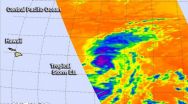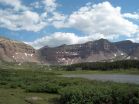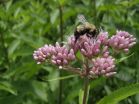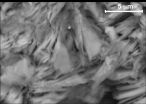NASA's Aqua satellite observes Supertyphoon Nangka
2015-07-09
(Press-News.org) NASA's Aqua satellite passed over Supertyphoon Nangka on July 9 and provided a visible and an infrared view of the large storm.
At 0700 UTC (3 a.m. EDT) on July 9 a typhoon warning was in effect for Agrihan, Pagan and Alamagan in the northern Marianas. A tropical storm warning is in effect for Saipan and Tinian. Nangka passed over Alamagan.
The Atmospheric Infrared Sounder or AIRS instrument aboard NASA's Aqua satellite gathered infrared temperature data on Nangka on July 9 at 03:23 UTC (July 8 at 11:23 a.m. EDT). At the same time, the MODIS instrument took a visible picture of the storm. The infrared data showed a large storm with powerful thunderstorms circling the 8 nautical-mile-wide (9.2 mile/14.8 km) eye of the storm. The coldest cloud top temperatures were near -81 Fahrenheit or -63 Celsius. Cloud top temperatures that cold are high into the troposphere and capable of generating heavy rain.
At 1500 UTC (11 a.m. EDT) on July 9, Typhoon Nangka's maximum sustained winds were near 135 knots (155.4 mph/250 kph). Nangka is a Category 4 typhoon on the Saffir-Simpson Wind Scale. Tropical storm-force winds extend out 145 nautical miles (166.9 miles/268.5 km) from the center making the storm about 300 nautical miles in diameter. Typhoon-force winds are somewhat compact, extending out 20 nautical miles (23 miles/37 km) from the center.
Nangka was centered near 18.1 North latitude and 144.1 East longitude, about 182 nautical miles north-northwest of Saipan. Nangka was moving to the west-northwest at 13 knots (14.9 mph/24.8 kph). Nangka was generating very rough seas, with wave heights to 43 feet (13.1 meters).
The Joint Typhoon Warning Center noted that the storm will continue to move west-northwest and begin to weaken starting July 10, and veer north-northwest.
INFORMATION:
[Attachments] See images for this press release:
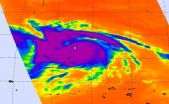

ELSE PRESS RELEASES FROM THIS DATE:
2015-07-09
Studying the gastric cancers of 15 Southeast Asian patients, researchers at The Jackson Laboratory, the Genome Institute of Singapore and other institutions identified five recurrent fusion genes, one of which appears to lead to cellular changes involved in acute gastritis and cancer.
Worldwide, close to a million cases of gastric cancers are diagnosed each year, and some of the world's highest incidence rates are in Asia (particularly in Korea, Japan and China).
The researchers, led by JAX Professor Yijun Ruan, Ph.D., and Axel M. Hillmer, Ph.D., of GIS, published ...
2015-07-09
LOS ANGELES (July 9, 2015) - After generating new brain tumor models, Cedars-Sinai scientists in the Board of Governors Regenerative Medicine Institute identified the role of a family of genes underlying tumor growth in a wide spectrum of high grade brain tumors.
"With these new genetic findings, our group of researchers plan to develop targeted therapeutics that we hope will one day be used treat patients with high grade brain tumors and increase their survival," said Joshua Breunig, PhD, a research scientist in the Brain Program at the Cedars-Sinai Board of Governors ...
2015-07-09
Tropical Storm Ela was born in the western-most part of the Eastern Pacific Ocean but has become the Central Pacific's first named storm. NASA's Aqua satellite took a look at the storm that's already battling wind shear to survive.
After developing as a depression on July 8, Tropical Depression 4E crossed over the 140 degree West longitude line that separates the Eastern Pacific from the Central Pacific Ocean region. The depression strengthened into a tropical storm early on July 9, taking a name from the Eastern Pacific tropical cyclone list and being renamed Ela.
When ...
2015-07-09
Traumatic spinal cord injuries are increasing with the population, and incidence is higher in older individuals, according to a Vanderbilt study that was published in the June 9 issue of the Journal of the American Medical Association.
The study, which analyzed data from 63,109 patients with acute traumatic spinal cord injury from 1993 to 2012, will help target specific populations for preventive measures, said lead author Nitin B. Jain, M.D., M.S.P.H, associate professor of Physical Medicine and Rehabilitation.
"We find that spinal cord injury as a result of falls is ...
2015-07-09
MINNEAPOLIS / ST. PAUL (7/9/2015) -- Draining tropical peatlands for oil palm plantations may result in nearly twice as much carbon loss as official estimates, according to a new study by researchers from the University of Minnesota Institute on the Environment and the Union of Concerned Scientists in the journal Environmental Research Letters.
Peatlands -- waterlogged, organic soils -- have developed over thousands of years as carbon storage systems. In Southeast Asia, peat swamp forests cover about 250,000 square kilometers, a land area about the size of Michigan. In ...
2015-07-09
Scientists at the University of East Anglia in collaboration with the University Pompeu Fabra in Barcelona have found a way to separate the medical benefits of cannabis from its unwanted side effects.
The research comes from the team that discovered how the main psychoactive ingredient in cannabis, known as THC, reduces tumour growth in cancer patients.
Their latest findings, published today in the journal PLOS Biology, reveal how the cognitive effects of THC are triggered by a pathway which is separate from some of its other effects.
That pathway involves both a ...
2015-07-09
Neutralizing antibodies (Nabs) are immune proteins that recognize, bind to, and trigger the elimination of virus before it can establish a chronic infection. How to elicit a potent Nab response capable of protecting against different HIV subtypes and against different modes of infection is critical to the development of an AIDS vaccine. Two studies published on July 9th in PLOS Pathogens provide results on Nabs that could help guide vaccine design. One shows what type of Nab "repertoire" can be generated following superinfection, and the second one examines the efficacy ...
2015-07-09
SALT LAKE CITY, July 9, 2015 - More than a quarter of the rain and snow that falls on continents reaches the oceans as runoff. Now a new study helps show where the rest goes: two-thirds of the remaining water is released by plants, more than a quarter lands on leaves and evaporates and what's left evaporates from soil and from lakes, rivers and streams.
"The question is, when rain falls on the landscape, where does it go?" says University of Utah geochemist Gabe Bowen, senior author of the study published today in the journal Science. "The water on the continents sustains ...
2015-07-09
Global warming is putting the squeeze on bumblebees. In the most comprehensive study ever conducted of the impacts of climate change on critical pollinators, scientists have discovered that global warming is rapidly shrinking the area where these bees are found in both North America and Europe.
Researchers examined more than 420,000 historical and current records of many species of bumblebees--and confirm that bumblebees are in steep decline at a continental scale because of climate change. The new research is reported in the journal Science.
ECONOMIC THREATS
This ...
2015-07-09
The discovery of a fiber-reinforced, concrete-like rock formed in the depths of a dormant supervolcano could help explain the unusual ground swelling that led to the evacuation of an Italian port city and inspire durable building materials in the future, Stanford scientists say.
The "natural concrete" at the Campi Flegrei volcano is similar to Roman concrete, a legendary compound invented by the Romans and used to construct the Pantheon, the Coliseum, and ancient shipping ports throughout the Mediterranean.
"This implies the existence of a natural process in the subsurface ...
LAST 30 PRESS RELEASES:
[Press-News.org] NASA's Aqua satellite observes Supertyphoon Nangka


